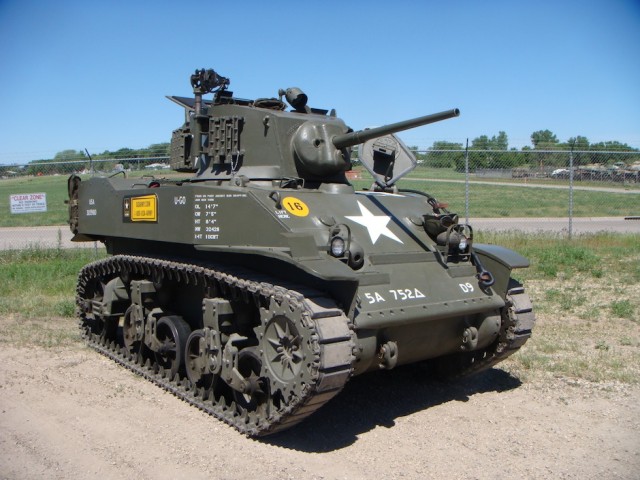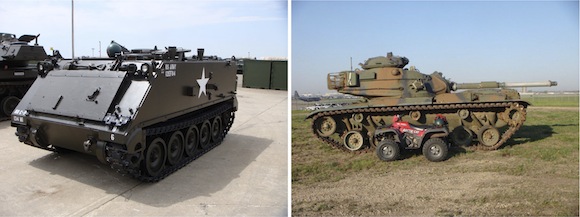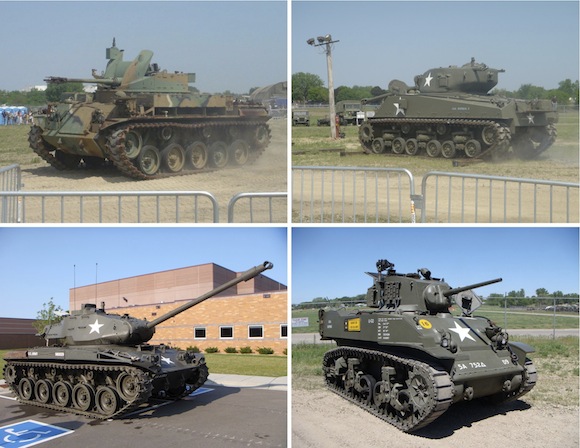
Rabbit Ears Audio has released its fifth library, called Military Vehicles, a huge collection of seven sfx packs, featuring recordings of the following military vehicles:
- M5A1 Stuart Tank: In service WWII and Korean War. Engine: 2x Cadillac Flathead V8.
- M60A3 Combat Tank: In service 1961–1997. Engine: Continental V-12
- M41A2 Walker Bulldog Tank: In service 1951-1970s. Engine: Continental AOS-895-3.
- M106A1 Mortar Carrier: In service 1960s-1980s. Engine: 212 hp Diesel.
- M4A2E8 Sherman Tank: In service 1942–1955. Engine Diesel GM 6046 (2×6-71 inline).
- M42A1 Duster Tank: In service 1953-1963. Engine: 6-cylinder air cooled gasoline.
- M75 Armored Personnel Carrier: In service Korean War. Engine: 6-cylinder AO-895-2.
All those vehicles where recorded by Michael Raphael and Rob Nokes of Sounddogs.com at the Fort Snelling Military Museum in Minnesota.
The gear used – Exterior: Schoeps MS pair, Neumann RSM 191; Onboard: Sanken CUB 01 (multiple), Sennheiser 835S(multiple), Crown PZM; Recorders: Sound Devices 744T and Deva 5,
[soundcloud width=”100%” height=”81″ params=”g=1&color=ff7700&show_comments=true” url=”http://api.soundcloud.com/tracks/12813891″]
[soundcloud width=”100%” height=”81″ params=”g=1&show_comments=true&color=ff7700″ url=”http://api.soundcloud.com/tracks/12806871″]
Military Vehicles is available now at Rabbit Ears Audio. The tanks are being sold individually at $95. There’s a complete collection priced at $499 and packed with over 30GB of sounds.
Now let’s read an interview I had with Michael and Rob, who talked about the making of this huge library.
DS: Could you tell us how do get started with this project and how was the process for getting access to record those vehicles?
MR: I was living in Minneapolis from 2007 – 2009 and Rob had hired me to record some different things from Minnesota and Wisconsin and one day we started exchanging emails about possible tanks there. I started to do some hunting around and after some research I found the Fort Snelling Military Museum on the outskirts of Minneapolis. The museum is not very visible to the public and oddly enough it is located on an Air Force National Guard base. Most of the locals have no idea that it exists.
When I first visited there, I found an amazing group of mostly civilians, who got together on weekends to restore the vehicles. Every weekend members are out at the museum working on vehicles and getting them up and operational for visitors. Everyone we met there was deeply passionate about the vehicles and the history they represented.
Our driver was Dan Little and was killer to work with. He is devoted to the museum and took 3 days off from his full-time job to drive the vehicles for us. Dan was also an experienced driver, which was extremely important! We knew that we could safely record while these heavy vehicles would be driving very closely by us. Also, Dan was very interested in what we were doing and would always point out where the interesting sounds were.
RN: It was all Michael I don’t recall the details other than being really excited to record a lot of Tanks with him.
 DS: How was your collaboration ?
DS: How was your collaboration ?
MR: I first met Rob back in late 2007 when I was working for a nationally distributed public radio show. I was on a project in LA for 3 months during the spring of 2008 and at that point I had never done any vehicle recording. I literally emailed Rob and asked him if I could do some work with him while I was there. I ended up crawling under cars with him and doing a few other gigs. During that time Rob was incredibly generous with his time and during those few months I learned an incredible amount. I had already been doing lots of field recording, but not on the scale that Rob had been, and it was great to learn first hand how he approached his work. Rob’s really passionate about finding new and interesting sounds and it’s hard not to have that rub off on you!
When we started discussing tanks I was back in Minnesota and we both knew it would be a great project. Rob came out and we recorded 7 vehicles in 3 days. It was a tremendous amount of work, but it was also tons of fun. Rob has so much experience recording cars (https://designingsound.org/2010/08/rob-nokes-special-guide-to-recording-cars/) which made everything go so smoothly. I had never had a tank roll by me at 30 MPH, which also meant I had never had a tank kick up a cloud of dirt and smoke over my body. We finished every day completely covered in dirt and the smell of fumes. At the end of the session I had to have all of the contacts for the buttons on my 744 replaced and the capsules on my schoeps cleaned.
RN: Very easy and simple, good team work. The location was adjacent to Minneapolis Airport so we had to always shoot shotgun and directional away from the taxi area. Fortunately the tanks are loud.
DS: Could you talk us about the mic choices and setup for exterior and onboard recordings?
MR: In terms of the exteriors I was used my Schoeps MS pair and Rob used a Neumann RSM 191.
RN: Like I mentioned the external mics battled airport noise as the tanks got further away from the mic, for this reason I shot shotgun directional. I recall that we really tore up one area with tanks and it got pretty dusty so we broke out some masks. As for the onboards Tanks are really loud, I will always remember the first tank I recorded with Greg King in 1993, it was shockingly loud inside. For this reason I stuck with microphones that could handle high SPL (sound pressure level).

DS: Was the process similar between all the vehicles or did you find any exception or variations of setup for recording different vehicles?
MR: There were two vehicles that had similar chassis, but all of them were different in so many ways. The personnel carriers we did were much lighter and could go much faster. They were also much smaller. Each vehicle had different engines and layouts, so while we set up our onboards we relied on our driver Dan to help us find the best spots to place the microphones. Some of the smaller vehicles like the Stuart and the Sherman were amazing to crawl inside and learn how cramped the quarters were for the men who had to use these vehicles in combat. It was quite amazing.
RN: I recall one Tank was like a jet engine, it was substantially louder than the other tanks. Other tanks had diesel engines that were smoother or rough sounding. I think the most noticeable thing about tanks is the treads, steel track or rubber track. Typically we only find rubber track in America because the Army does not want to tear up all the roads with steel tracks. As I recall I think one of the tanks had steel track.
DS: Anything else you’d like to add?
MR: Personally we’re very excited for this library and the diversity of vehicles we put together:
- M5A1 Stuart Tank
- M60A3 Combat Tank
- M41A2 Walker Bulldog Tank
- M42A1 Duster
- M106A2 Mortar Carrier
- M4A2E8 Sherman Tank
- M42A1 Duster
- M75 APC
Some of this vehicles have had little to no coverage previously available. I also hope to have more opportunities to work with Rob again in the future.
RN: It was a pleasure to work with Michael and get to know him, and Michael shares the passion of sound recording.
Hello,
I’m strongly considering purchasing your work for a game I’m working on.
The sounds sound very crisp and HD. The only problem is that we also need Axis WWII era tanks and Allied and Axis Tankgun shots. Would you perhaps know where we could get these kinds of things?
Best,
Samuel
Rabbit Ears Audio Releases Military Vehicles SFX Library (Q&A Included) | Designing Sound
[url=http://www.g1x24olx4qpf05rgjp9n4486is5942u0s.org/]ufptqqmgcw[/url]
afptqqmgcw
fptqqmgcw http://www.g1x24olx4qpf05rgjp9n4486is5942u0s.org/